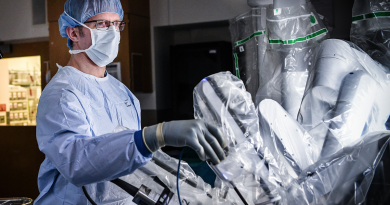Yearly exams and lifestyle changes may prevent No. 1 killer
 Heart disease is the leading cause of death for men and women in the United States. And coronary artery disease is the most common type of heart disease, killing more than 380,000 people in 2020.
Heart disease is the leading cause of death for men and women in the United States. And coronary artery disease is the most common type of heart disease, killing more than 380,000 people in 2020.
“Coronary artery disease happens when you have plaque that has built up in the wall of the coronary artery that supplies blood to the heart,” explains Dr. Ourania Preventza, a cardiothoracic surgeon at Baylor College of Medicine. “This plaque causes blockages or narrowing so there is not enough blood going into the heart muscle. This can be life-threatening.”
For a lot of people, the first symptom of coronary artery disease is a heart attack. That is why it is important to have a yearly physical exam, including blood work and blood pressure check, for signs that your heart is in distress.
Bloodwork can alert to all kinds of problems that may affect the heart, Preventza says. For example, if the thyroid is not functioning properly, it can increase cholesterol if it’s not managed well.
There are many known causes of heart disease:
- High cholesterol
- High blood pressure
- Smoking
- Obesity
- Diabetes
- Lack of exercise
- Genetics
- Autoimmune diseases (lupus, rheumatoid arthritis)
Women have unique risk factors:
- Pre-term delivery
- Pre-gestational diabetes
- Increased blood pressure condition during pregnancy (preeclampsia, eclampsia)
- Postmenopausal
Of the risk factors for developing heart disease, obesity (defined as a body mass index > 30), high blood pressure, high cholesterol and type 2 diabetes are the most modifiable based on lifestyle changes. The American College of Cardiology and American Heart Association guidelines for preventing cardiovascular disease are based on decades of research and can easily be summarized into three primary categories that impact heart health: diet, exercise and abstaining from tobacco use.
“The most important thing is prevention,” says Preventza. “Don’t smoke, lower your blood pressure and maintain a healthy weight. Eat vegetables and a low-salt diet.”
Diet
Eating a diet that is mainly composed of fruits, vegetables and whole grains is key. For protein, studies have shown that non-animal sources such as nuts, legumes and protein-packed veggies such as broccoli are more beneficial than meat. For the carnivores out there, stick to lean cuts of poultry and fish, reserving red meats for special occasions. Avoid processed red meats (deli meat, bacon, etc.), foods with trans fats, refined carbs and sugar-sweetened beverages. These have been shown in multiple studies to increase deaths related to heart disease. The other added benefit to heart-healthy foods is that they have low caloric density, which can facilitate weight loss, improve blood sugar control for diabetics and improve blood pressure, as healthier foods are naturally lower in sodium.
Exercise
For exercise, it is recommended that adults participate in at least 150 minutes per week of moderate-intensity or 75 minutes per week of vigorous-intensity aerobic activity. That sounds like a lot, but the impact is cumulative, meaning it can be broken up into smaller increments and does not have to be performed all in one setting.
Examples of moderate-intensity activity include brisk walking, recreational swimming or bike riding and active yoga. High-intensity activities include jogging/running, swimming laps or playing tennis. If you are relatively sedentary, start slow and increase duration and intensity to recommended amounts. And if you have underlying health conditions, talk to your medical provider before starting an exercise program.
Tobacco
Tobacco use is always a no. Smoking, chewing tobacco and second-hand smoke all increase the risk of cardiovascular disease. Cutting back on tobacco use, although helpful on the road to quitting, does not eliminate risk. Even low levels of tobacco exposure increase the chances of a heart attack. Although there is less data on e-cigarettes, they are known to be associated with an increase in high blood pressure and abnormal heart rhythms, so these devices are not recommended substitutes. Talk to your healthcare provider about other proven smoking cessation aids, such as gums, patches or prescription medications.
In addition to altering lifestyle, a procedure called coronary artery bypass grafting (CABG) may be necessary. The purpose of CABG is to improve blood flow to your heart by taking healthy vessels from another part of your body to bypass the blocked arteries.
Preventza says it’s important to have a surgeon who specializes in coronary surgery with advanced revascularization techniques including multi-arterial grafting, bilateral internal thoracic arteries when appropriate and use of radial arteries when appropriate.
Learn more about Baylor Medicine cardiothoracic surgery services.
By Jana Bishop, cardiothoracic physician assistant at Ben Taub Hospital, and Tiffany Harston, communications associate in the Michael E. DeBakey Department of Surgery at Baylor College of Medicine



